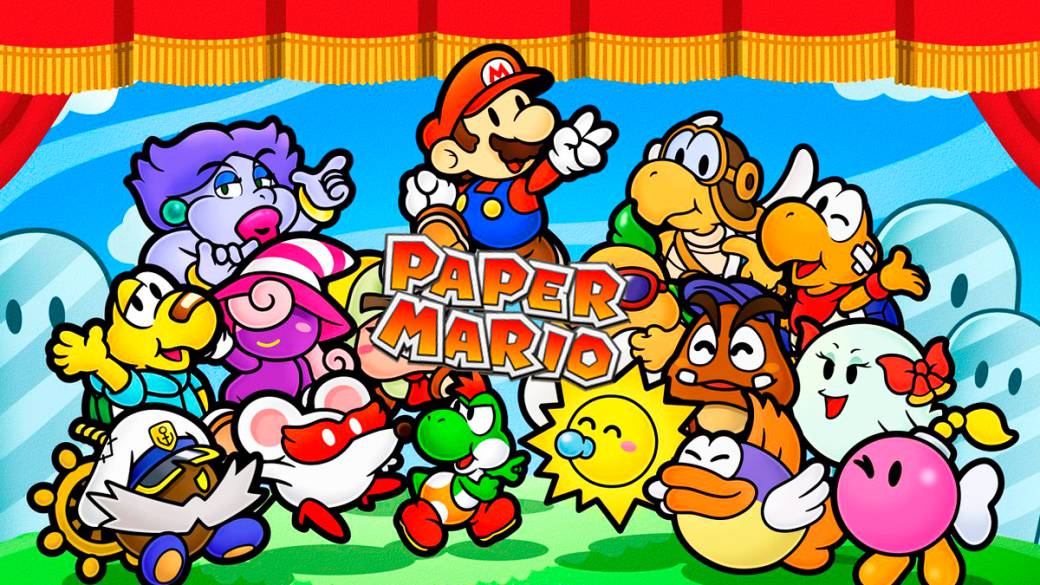
One month after the premiere, the new Paper Mario: The Origami King trailer alleviates various doubts and clarifies fans what to expect from the new installment.
Following the surprising announcement of Paper Mario: The Origami King for Switch, which until last month we did not even know existed and is now just a few weeks away (premieres on July 17), a debate with roots in the past decade. Specifically at E3 in 2006, when Intelligent Systems announced that the next installment was going to abandon the traditional role-playing of The Millennial Gate to try its luck with a 2D-3D hybrid with a much more platform cut and real-time combat. Since then, the saga has been characterized by experiencing practically more than any other from Nintendo, always keeping both its colorful paper worlds and tons of humor at the forefront, but looking for new playable frames to frame everything.
This, in addition to fresh experiences, has also brought players upside down who did not always receive what they asked for. The Origami King’s announcement, as well as unexpected, was also cryptic enough to leave enough doubt in the air. What kind of Paper Mario is this? What does it take from the previous ones and what does it bring new? Luckily, since Friday we have access to a new trailer and more detailed information that allows us to narrow down the intentions of Intelligent Systems a little better. If you have not seen it, we leave it below these lines, but before we break it down, we are going to explore the creative conflict that causes some fans to have had a lukewarm reaction to the original announcement, or caused the most recent installments to not have been evaluated since the most favorable prospect despite having its own strengths. This is the story of the thousand faces of Paper Mario, and how versatility can be both a source of wonder and frustration.
Two classics, fourteen stars
First things first and, although obvious to many, it is unnecessary to remember that both the original Nintendo 64 Paper Mario and its GameCube sequel were games cut by the same pattern. By this we do not simply mean that they share philosophy in the design of levels (whether they are villages, transit roads or dungeons), the fundamentals of combat (in turns and with an emphasis on command timing), the personalization system (equipment of medals with different properties and requirements) or the hilarious humor displayed by countless secondary characters. This is the case, but it goes further, since both games have an almost traced structure: Mario arrives in an area, meets a character who decides to accompany him on the adventure, together they progress through a similar sequence of events (road to the dungeon , the dungeon itself and the boss), get one of the seven stars that mark the end of the chapter and give way to an intermission where we play with Peach – kidnapped, but more proactive – before restarting the cycle.
It is, of course, a simplification that should never be taken as a negative. Both Paper Mario were created with the same mold, but the flavor varies according to the ingredients that are added to the container (La Puerta Milenaria, for example, also added sections with Bowser to the intermediates). The very resource of the search for seven stars, in fact, goes back to Square’s Super Mario RPG – literally subtitled Legend of the Seven Stars – but the Intelligent Systems saga made it their own by weight shifting as a rethink of combat and peer implementation. Introduced more gradually and promoting their rotation (they have exclusive abilities to use in and out of combat), they keep the development of both Paper Mario more varied than in the SNES game, and reinforce the identity of each individual arc – the most important ones , since the final objectives do not stop being variants of the classic rescue of Peach-.
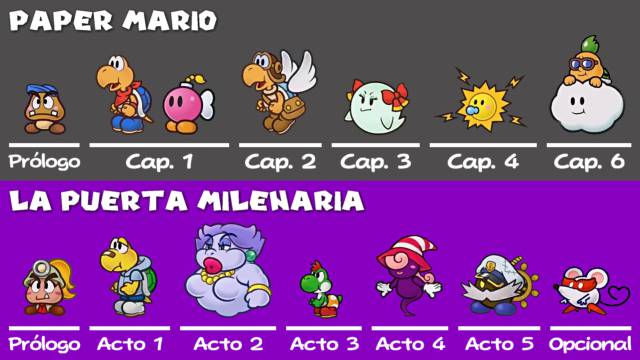
The Paper Schism: Three Series for a Saga
It was an efficient formula, and Intelligent Systems knew how to counteract the predictability towards which it could be driven with great doses of humor, creativity in design and the occasional rupture of its own format (avoiding dungeons or the exact interrelation between colleagues and chapters) . However, at the development level – or production – it seemed not to be enough, which is why today, even before the departure of The Origami King, there are already more Paper Marios away from this formula than Paper Marios created from her. This is where things get interesting, at least from an academic, say, point of view.
Because although the absence of what we could call “Paper Mario 3” in the most continuist sense is painful for some fans, it has led us to a situation in which the saga is no longer simply a “saga”, but rather a set of series with different design philosophies, mechanics, narrative approaches. And this is something that not only impacts on how games work as such or how they build their worlds, but on the players’ own perception of both the quality and the “adequacy” of what the name Paper represents – or should represent – Mario.
It is another way of saying that there is a considerable sector of fans who like the first two, but not the next three; Another sector that, in addition to the first two, also likes Super Paper Mario, but not Sticker Star or Color Splash; and even another one of those who did like the most recent duo, but has reservations with the Wii game. There are other possible combinations, of course, but the general division of criteria is easy to define because it is not based on a mere question of quality, but on what each series pursues at a conceptual level.
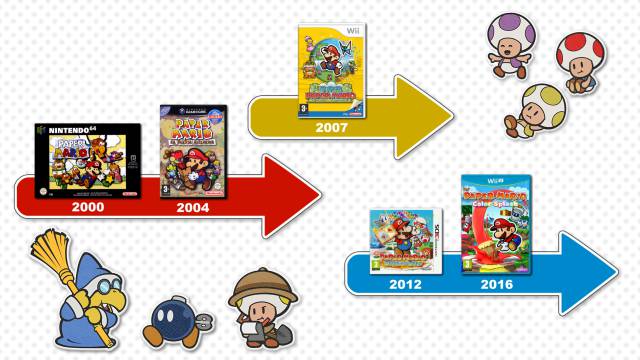
Super Paper Mario rejected turns, medals and comrades with narrative weight – the pixels only maintain certain playable functions. He did keep the division into thematic chapters that culminate in the achievement of a star –well, now heart–, but these were fragmented into subchapters to better fit the semi-platformer mold. In return, he offered four protagonists with differentiated skills and management, as well as the original concept of the three-dimensional exploration of lateral scroll levels. In addition, the script in general lines was still pure “Paper Mario” – albeit less restrained – both in terms of interactions with NPCs and plot development.
The division into subchapters and certain limitations of the perspective made the arrival to each chapter rarely shake things up too much at a playable level – again, there were notable exceptions such as a shoot ’em up space excursion or a dueling marathon one against one – but something always present was the discovery of extravagant worlds, races and characters, which were not only different from those in the previous chapter, but also from other Paper Mario and plumber games in general. It is unquestionable that Super sacrificed depth in more than one sense, but situations such as the encounter with the chameleon otaku Francis, the persecutions of the sinister Mimi, the unexpected visit to the world -1 (the “Massacá”) or the tragic story of Count Cenizo and Pistina served to resonate with a still quite large part of the fans of the first installments.
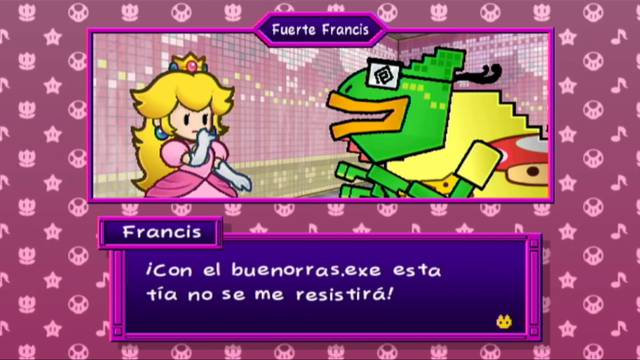
But against all odds, that was not the idea that Intelligent Systems came up with. In a now-famous interview conducted by the late Satoru Iwata with various team members, a hard-to-believe fact was revealed: Less than 1% of respondents at Club Nintendo expressed interest in the story of Super Paper Mario. It should be noted that, although we do not have the complete information, this type of survey was used to redeem the points of the game and used to take place as soon as it was purchased or shortly after starting it. From that perspective, it makes sense that most of them pointed to 2D-3D as the main attraction, much easier to sell through trailers than a narrative that unfolds over the hours and naturally the studio neither can nor wants to burn in promotional material.
Consumables and contradictory creativity
And then, of course, there is the Miyamoto factor. Father of Mario, Donkey Kong and Zelda, and supervisor of countless Nintendo titles throughout the decades, his profile has always been that of a creative focused on the game as a game, worth the redundancy. In the construction of an environment where the user can enter, experiment and express himself with the remote control. History exists, but more as a context than as a driving motor. After his comments during the development of Sticker Star, this mentality conditioned the design of the 3DS game and its sequel much more than that of Super. Intelligent Systems de-escalated from a creative model where the conceptualization of characters, enemies and objects often responded to merely aesthetic functions, to another where the starting point was the classic Mario universe (Bros, World) and from there it was built with views to playable functions.
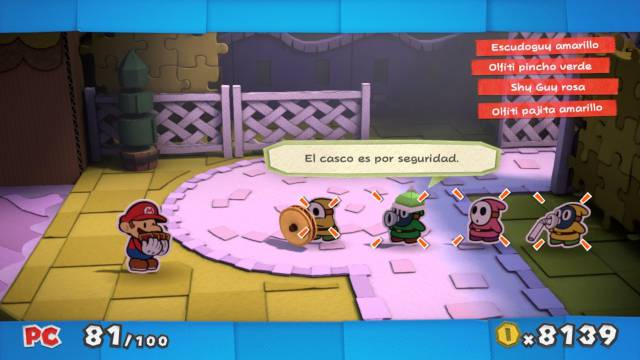
The result had advantages and disadvantages, and resulted in an even greater split than with the arrival of Super. Looking on the bright side, both Sticker Star and Color Splash returned to 3D levels with more substantial exploration, fewer interruptions for chats, and even a structure less tied to the sequentiality of the seven stars (in Sticker Star you can get several in different order, and the Color Splash branching map dilutes the concept of worlds.) On the other hand, combat systems using stickers and cards restored turns and a greater tactical component: not so differently than a Survival Horror like Resident Evil, attacks – jumping on an enemy, shooting a fireball, hitting with a hammer – they were single-use consumables, so there was a new element of management when it came to getting them, using the most suitable ones in each situation and even avoiding combat if we preferred to keep provisions.
Of course, the first and perhaps most important lack of understanding between creators and some users emerged from this. Intelligent Systems’ intention was to offer an original and flexible system. Attacks were accomplished by fighting, scouting, or in stores, and the training was not about repeating bouts to gain experience, but rather studying how to “invest” worse stickers to “win” better stickers, or more appropriate for dangers to come. But, beyond tweaks that could have been applied here and there –something that was done in some cases in Color Splash, a more refined version of the same proposal–, the study underestimated the power of numbers. The value that has both a practical and psychological level to see how the experience rises, how each combat has a tangible and constant impact. Yes, the player likes to experiment, but he also finds comfort in certainty and routine. In having a series of fixed commands with clearly quantifiable effects. These systems, although exploitable with the appropriate methodology, do not put the same kind of safety net at its most basic level, nor do they jump to scale too much – compared to Paper 1 and 2, not Super – because they are aware of it.
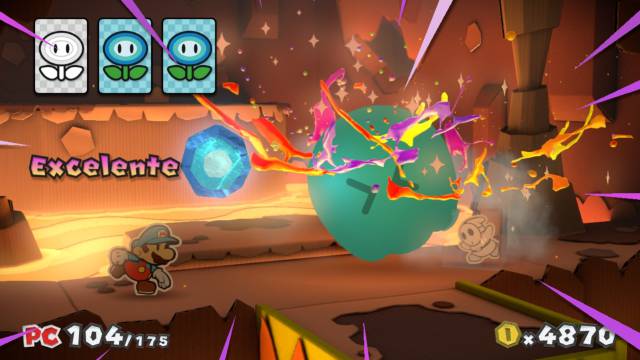
The new reality of Paper Mario is that it is an expressive vehicle that Intelligent Systems uses to explore different ideas. Of course, this brings us back to the Miyamoto factor, and the small contradiction of allowing yourself to try new and exotic things on the playable terrain, but still sticking to classic Mario characters like Toads, Goombas, Shy Guys and so on as long as familiar: although all the games are full of verbal and contextual humor, it does not always impact with the same forcefulness due to that more derivative context. Because something that Miyamoto overlooked – nobody is perfect – is that an RPG does not necessarily follow the same rules of other genres and the creativity displayed in the aesthetics of worlds and characters is almost as important as merely functional. Or what is the same, when a player engages in an adventure of 15 or more hours, he usually does it with the expectation of seeing new things, not just playing them.
On paper – never better said – Color Splash has one of the best scripts ever written for a Nintendo game. The amount of visual gags, puns, fourth wall breaks and variety of situations would give for various entries. But at the end of the road, after hours of play and smiles, what remains with the player is the recognition of the creativity that the team has, not so much of the specific characters that have been used to transfer the jokes from the paper to the screen. At almost the other extreme we find the original, which at the script level is a much simpler game. It enhances development with humor, but is not as self-conscious or consistent in creating crazy situations. However, it is as or more loaded with memorable encounters because there is an extra effort to build a Mushroom Kingdom that is specifically theirs without worrying about how they are represented by Super Mario, Mario Party or Mario Kart when their turn comes.
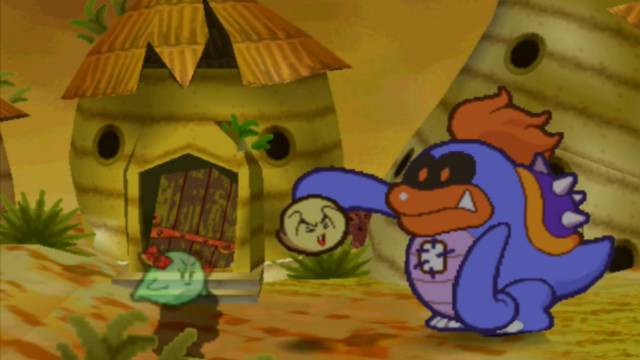
The Origami King: Much new, something old
For now it is impossible to know for sure how people – press, old fans and newcomers – will react to The Origami King. The game seems to be a continuation of the series released by Sticker Star, but it introduces more changes regarding Color Splash than the latter regarding the 3DS game. In the field of characters, for example, the combination of traditional paper cutouts with other materials such as cardboard, papier-mâché, cardboard or the frequent appearance of everyday objects – scissors, staplers, etc. – create aesthetic contrasts very similar to those of both games, but it is something in which the delivery of Switch redoubles as part of the plot premise by posing the villains as origami-created figurines to endow them with a different appearance and texture.
It may still be a somewhat conservative approach to character design, but it maintains the upward creative trend of Sticker Star and Color Splash. In addition, it comes with a new turntable combat system that introduces the clever idea of aligning enemies to maximize the effectiveness of attacks. Apart from adding an obvious tactical component, since the number of rotations is limited, this system works as a team with money, which is achieved by winning battles – we do not yet know if there is experience – and in addition to buying things outside, it is used to manipulate the time trial factor. Something that can be fundamental especially in the confrontations against bosses, where this system of rings, rotations and positions is reversed: our opponent occupies the central position and our mission is to draw routes for Mario to advance around him, attack and even get objects arranged along the way.
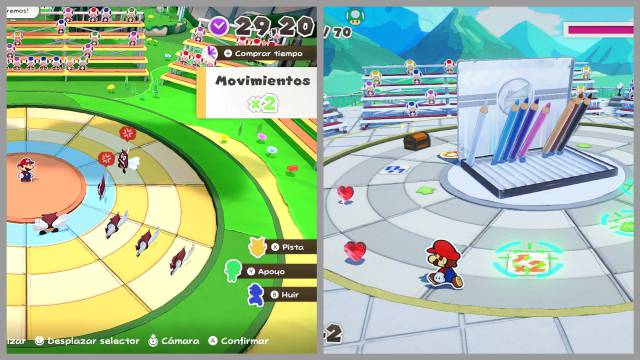
Already looking at the attacks themselves, the use of consumables returns, but with two important changes: on the one hand, the basic actions (boots and hammer) are now of unlimited use; On the other hand, the ones that do wear out (powered versions with different attributes) are no longer for single use like stickers, but instead have a durability meter that allows them to be reused – we do not know to what extent or if it varies depending on the weapon– . In this way, the game puts the protection network we were talking about before, allowing you to resort to the most basic commands to dispatch simple fights and then escalate with special attacks, more powerful, but that require more selective administration as, for example, they could do it. attacks that consumed flower points (magic) in the first installments.

This customization of Mario via equipment, as we mentioned before, has its origin in the medals, on which both these special attacks and a multitude of passive improvements or other effects that conditioned the combat depended. And, at least to some extent, that seems to be the idea for The Origami King, which also introduces accessories that pick up that second facet with bonuses for life, defense and other properties. It’s something the available footage hasn’t delved into yet, but it certainly sounds like a positive addition to shape the gaming experience more than in previous installments.
Speaking of reinterpretations of classic ideas, something that also comes back revised from La Puerta Milenaria is the public. Just like in the GameCube game, we once again have an audience with the capacity to actively participate in fights, although in The Origami King their number does not increase as we level up, but if we take the time to explore and help Toads wrinkled by the scenarios. Once back in combat – and again, in exchange for a monetary investment – these allies join the battle for a turn to do damage to enemies and even reward us with some item or weapon.

Last but not least, we also find the return of the companions. Like Sticker Star with Tina or Color Splash with Baldo, The Origami King introduces a new co-star, Olivia, who leads the way – Mario’s mutism is an unbreakable tradition – and transforms into different origami creatures or opens up access to other skills that characterize this delivery – such as the possibility of reaching out to manipulate the scenarios. But this time, in addition, other companions will also join us. Their role is not exactly the same as in yesteryear, since they do not have their own turn during the fights, but they can be invoked to participate in them – we do not know under what conditions – and they can also be expected to contribute to the script by replying to Olivia or other secondary . It is one of those aspects that were left out in previous installments, so it will be interesting to see what they contribute to the narrative and personality of each section.
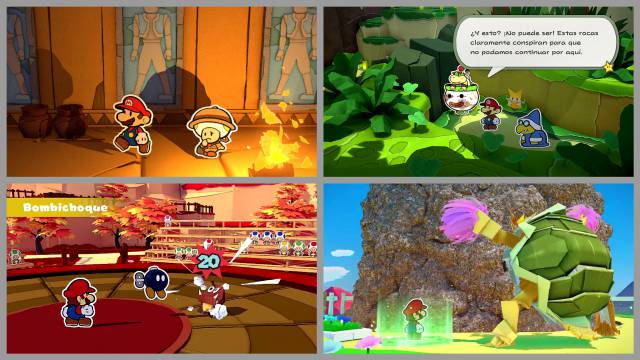
And all this without even going into the use of magic confetti to repair scenarios, the minigames that dot the development or other ideas that will be covered in depth when the Reviews comes. We are scratching the surface and it is early to draw conclusions, but it does not seem risky to say since the game takes several steps in directions that many players wanted without depriving it of its own identity. One that is not limited to being Paper Mario 3 or Color Splash 2. At the end of the day, regardless of the feelings of each, something undeniable is that Intelligent Systems does not go with the autopilot and all the deliveries offer something different and worked . Perhaps one day the most staunch fans of the original or The Millennial Gate will receive a sequel, a remaster or a remake. But the fact that today is not that day does not mean that there is no merit in the alternative. The Origami King is also Paper Mario. A very promising one, and who seems to take both his world and his humor seriously.

